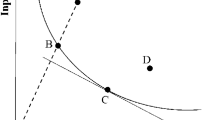Abstract
In paper we examine the conditions under which aggregate overall Farrell efficiency decomposes by both observation (i.e., firms) and source (i.e., technical and allocative efficiency) using the same set of aggregation weights. These conditions require firms to produce a single output with a homogenous of degree \(r > 0\) technology. Then, Farrell decomposition at the firm level is also preserved at the industry level.
Similar content being viewed by others
Notes
Following Diewert (2005), metrics that are in difference form are called indicators and metrics that take the form of ratios are called indices.
For the relation between the denominator rule and geometric aggregation see Färe and Karagiannis (2020).
The last equality in the first relation in (8) is obtained by applying the denominator rule in \(TE^{k} = \left( {y^{k} /\tilde{y}^{k} } \right)^{1/r}\), which results in \(TE = \mathop \sum \nolimits_{k = 1}^{K} \left[ {{{\left( {\tilde{y}^{k} } \right)^{1/r} } \mathord{\left/ {\vphantom {{\left( {\tilde{y}^{k} } \right)^{1/r} } {\mathop \sum \nolimits_{k = 1}^{K} \left( {\tilde{y}^{k} } \right)^{1/r} }}} \right. \kern-\nulldelimiterspace} {\mathop \sum \nolimits_{k = 1}^{K} \left( {\tilde{y}^{k} } \right)^{1/r} }}} \right)(y^{k} /\tilde{y}^{k} )^{1/r} = {{\left[ {\mathop \sum \nolimits_{k = 1}^{k} \left( {\tilde{y}^{k} } \right)^{1/r} } \right]} \mathord{\left/ {\vphantom {{\left[ {\mathop \sum \nolimits_{k = 1}^{k} \left( {\tilde{y}^{k} } \right)^{1/r} } \right]} {\left[ {\mathop \sum \nolimits_{k = 1}^{K} \left( {y^{k} } \right)^{1/r} } \right]}}} \right. \kern-\nulldelimiterspace} {\left[ {\mathop \sum \nolimits_{k = 1}^{K} \left( {y^{k} } \right)^{1/r} } \right]}}\).
In the case where output-oriented efficiencies are defined to be less than or equal to one, the appropriate aggregation weights are in terms of potential revenue shares.
This is actually how the last equality in the first relation in (12) is obtained: using the denominator rule for \(TE^{k} = y^{k} /\tilde{y}^{k}\) result in \(TE = \mathop \sum \nolimits_{k = 1}^{K} \left( {{{\tilde{y}^{k} } \mathord{\left/ {\vphantom {{\tilde{y}^{k} } {\mathop \sum \nolimits_{k = 1}^{K} \tilde{y}^{k} }}} \right. \kern-\nulldelimiterspace} {\mathop \sum \nolimits_{k = 1}^{K} \tilde{y}^{k} }}} \right)\left( {y^{k} /\tilde{y}^{k} } \right) = {{\left[ {\mathop \sum \nolimits_{k = 1}^{k} \tilde{y}^{k} } \right]} \mathord{\left/ {\vphantom {{\left[ {\mathop \sum \nolimits_{k = 1}^{k} \tilde{y}^{k} } \right]} {\left[ {\mathop \sum \nolimits_{k = 1}^{K} y^{k} } \right]}}} \right. \kern-\nulldelimiterspace} {\left[ {\mathop \sum \nolimits_{k = 1}^{K} y^{k} } \right]}}\).
When applying to output-oriented efficiency measures are less than or equal to one, the Färe and Karagiannis (2014) results imply that they can also be aggregated with input-based weights, namely actual cost shares.
References
Aczel J (1990) Determining merged relative scores. J Math Anal Appl 150:20–40
Aparicio J, Zofio JL (2017) Revisiting the decomposition of cost efficiency for non-homothetic technologies: a directional distance function approach. J Prod Anal 48:133–146
Aparicio J, Pastor JT, Zofio JL (2015) How to properly decompose economic efficiency using technical and allocative criteria with non-homothetic DEA technologies. Eur J Oper Res 240:882–891
Bogetoft P, Färe R, Obel B (2006) Allocative efficiency of technically inefficient production units. Eur J Oper Res 168:450–462
Boussemart JP, Briec W, Peypoch N, Tavera C (2009) Returns to scale and multi-output production technologies. Eur J Oper Res 197:332–339
Briec W, Dervaux B, Leleu H (2003) Aggregation of directional distance functions and industrial efficiency. J Econ 79:237–261
Camanho AS, Dyson RG (2008) A generalization of the Farrell cost efficiency measure applicable to non-fully competitive settings. Omega 36:147–162
Diewert WE (2005) Index number theory using differences rather than ratios. Am J Econ Sociol 64:311–360
Färe R, Grosskopf S (2004) New directions: efficiency and productivity. Kluwer Academic Publishers
Färe R, Karagiannis G (2014) A postscript on aggregate Farrell efficiencies. Eur J Oper Res 233:784–786
Färe R, Karagiannis G (2017) The denominator rule for share-weighting aggregation. Eur J Oper Res 260:1175–1180
Fӓre R, Karagiannis G (2020) On the denominator rule and a theorem by Janos Aczel. Eur J Oper Res 282:398–400
Färe R, Mitchell T (1993) Multiple outputs and “homotheticity.” South Econ J 60:287–296
Färe R, Primont D (1995) Multi-output production and duality: theory and applications. Kluwer Academic Publishers, Dordrecht
Färe R, Zelenyuk V (2003) On aggregate Farrell efficiencies. Eur J Oper Res 146:615–620
Färe R, Zelenyuk V (2005) On Farrell’s decomposition and aggregation. Int J Bus Econ 4:167–171
Farrell MJ (1957) The measurement of productive efficiency. J R Stat Soc 120:253–281
Leleu H, Briec W (2009) A DEA estimation of a lower bound for firms allocative efficiency without information on price data. Int J Prod Econ 121:203–211
Mendelova V (2021) Decomposition of cost efficiency with adjustable prices: AN application of data envelopment analysis. Oper Res Int J 21:2739–2770
Portela MCAS, Thanassoulis E (2014) Economic efficiency when prices are not fixed: disentangling quantity and price efficiency. Omega 47:36–44
Tone K (2002) A strange case of cost and allocative efficiencies in DEA. J Oper Res Soc 53:1225–1231
Tone K, Tsutsui M (2007) Decomposition of cost efficiency and its application to Japanese-US electric utility comparisons. Socioecon Plan Sci 41:91–106
Acknowledgements
We would like to thank two anonymous reviewers for useful suggestions in an earlier version of this paper.
Author information
Authors and Affiliations
Corresponding author
Additional information
Publisher's Note
Springer Nature remains neutral with regard to jurisdictional claims in published maps and institutional affiliations.
Rights and permissions
About this article
Cite this article
Färe, R., Karagiannis, G. Aggregation and decomposition of Farrell efficiencies. Oper Res Int J 22, 5675–5683 (2022). https://doi.org/10.1007/s12351-022-00721-1
Received:
Revised:
Accepted:
Published:
Issue Date:
DOI: https://doi.org/10.1007/s12351-022-00721-1




